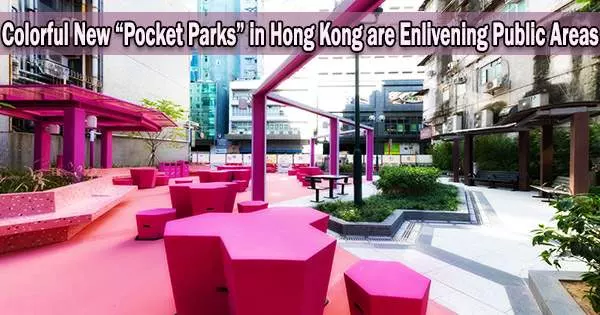An Instagrammer’s dream, Portland Street Rest Garden is bright pink and dotted with octagonal stools. However, at this park, tucked between two skyscrapers on a busy Hong Kong street, local retirees play checkers on fuchsia gameboards, while elderly neighbors chat on the rose-colored benches, purple grass swinging in the pots behind.
While 75% of Hong Kong’s territory, which includes more than 200 islands, is made up of lush jungle and country parks, urban Hong Kong is short on space. Its residents have just 2.7 square meters (29.1 square feet) of public space per person, according to non-profit think tank Civic Exchange compared to 5.8 to 7.6 square meters (62.4 to 81.8 square foot) per person in other dense Asian metropolises like Singapore, Tokyo, and Shanghai. There is a link between access to nature and mental health, with residents who are closest to public open spaces reporting lower levels of anxiety than residents who are farther away.
Therefore, parks like the one on Portland Street might provide a break from the little towers that the majority of people reside in.
The non-profit organization Design Trust, which promotes design-based programs, gave it a facelift that gave it an eye-catching design. The organization has been redesigning four of the city’s micro parks in a bid to make a “macro transformation” to public space, said Marisa Yiu, co-founder and executive director of Design Trust.
In contrast to other parks in the city, many of which have the same, generic look neutral tiles or concrete slabs, fenced-off greenery, and single-seat benches Design Trust wanted to break the mold, by creating distinct designs that could showcase communities’ “unique stories.”
Four distinct teams imagined the makeover of the micro parks while collaborating with the Leisure and Cultural Services Department (LCSD), which oversees public parks in Hong Kong. At Portland Street, the redesign increased seating capacity from 16 to 81 people, and greenery by 26%.
Play is for the people
Design concepts for the parks were created in 2018, but the pandemic meant the LCSD and the Architectural Services Department didn’t begin construction until 2021. The project, called “Play is for the people,” centered around fun.
“Play should be accessible for all ages, whether it’s adults playing chess or kids running around,” said Yiu.
And play is indeed at the center of the project’s first park, Yi Pei Square, in Tsuen Wan, which opened in April 2021. The long, narrow courtyard was once paved and mostly used as a pathway. It is bordered by residential buildings. The 930 square meter (10, 010 square foot) property, however, was turned by Design Trust into a “communal living room” featuring play areas, exercise areas, and benches.
Involving the community was a key part of the process. The team built prototypes of the park’s various features, displayed them in co-working spaces and shopping centers to test their concepts, and solicited feedback from the local community. Children suggested games and the size and shape of playground equipment, such as the slide, which was widened so that they could race down it two at a time.
“The designers learned a lot about how people live,” said Yiu. “What you see now in Yi Pei Square is generated by the community.”
At the park on Portland Street, which opened in September 2021, the design team wanted to modernize the site while still highlighting the area’s history.
To balance out the bold color, the team decided to split the 376-square-meter (4,047-square-foot) park in half with a zig-zag line down the center: while one side is Barbie-pink, the other is restored to look like a typical Hong Kong rest garden from the 1980s, complete with hexagonal geometry, bamboo and shaded seating areas.
For the designers, pink was the perfect choice to revitalize the park: it inspires joy and compassion, and contrasts with the greenery of the foliage, to create a vibrant yet relaxing atmosphere, said Yiu.
“The designers were so empowered by this color that it just made sense,” she added.
Locals appear happy with the results. Septuagenarian Mr. Kong, who only gave his surname, says he likes the park’s new layout. He has lived here for decades and claims the neighborhood is cleaner now than it ever was. Peter, a man in his sixties who frequently eats lunch outside in the park, expresses his gratitude for the availability of such areas near residences.
Short on space
Bringing new ideas on how to design public spaces can be challenging. It has taken some convincing to get city planners to accept more flexible areas, including benches without barriers or transportable furniture, according to certain instances Yiu cites that can actually deter people from relaxing or lounging, such as benches and chairs with barriers or at sloping angles.
Additionally, the teams continuously improve their present and upcoming ideas by taking lessons from how the parks are used. For example, at Portland Street, tables and chairs have suffered from chipped paint. Now, Design Trust is exploring more resilient paint and coating materials. “These are the things that you can’t do without testing, and trial and error,” said Yiu.
The Design Trust isn’t the only organization getting creative with Hong Kong’s limited space. In May 2022, the city’s first rooftop skatepark opened at H.A.N.D.S shopping mall in Tuen Mun, joining the existing rooftop basketball court designed by One Bite Studio. Other basketball courts across the city have been decorated with colorful designs too, including Shek Lei Grind Court which used 20,000 pairs of recycled Nike sneakers for its rubber surface.
The government has green-lit the rejuvenation of a further 170 parks and playgrounds in a five-year project. While this won’t be in collaboration with HKDT, Yiu said that the micro park pilot has helped to “mobilize and accelerate” the new policy.
A spokesperson from the LCSD said that innovative designs would make parks more attractive, and along with projects such as an inclusive playground built at Tuen Mun Park, the experience and design processes from the micro park pilot will help to “implement the transformation of public play spaces.”
Heritage through design
Design Trust’s third park, Hamilton Street in Yau Ma Tei, is set to open in October, while the fourth will open by the end of the year. The design team for Hamilton Park is commemorating the area’s rich history of craftsmanship.
The region is home to ancient structures and temples, as well as a large population of “sifu,” or master crafters, whose companies have endured for centuries. The park’s components, including copper lighting fixtures and signage built from the unique chopping boards visible in butcher shops across the city, were created by local artisans that Design Trust sourced.
It gives an opportunity to the designers, but it also (sparks) neighborhood transformation.
Marisa Yiu, founder of Hong Kong Design Trust
A huge table in the park’s middle serves as a gathering place for the neighborhood, and an old banyan tree that has been preserved is another tribute to the past.
According to Yiu, the cost of each park is the same per square meter as the generic parks seen elsewhere around the city except for Yi Pei Square, which received some extra funding.
She hopes that these prototype pocket parks will inspire cities to think more creatively about the design of public spaces and step away from the “cookie cutter formula.”
“We don’t want 20,000 pink parks,” Yiu said. “Design Trust is really looking at Hong Kong’s heritage, the challenges of a park’s context, but also health and wellbeing, and sustainable futures. Each park has a way to engage differently. It’s a cultural responsibility for everyone to be involved.”
















